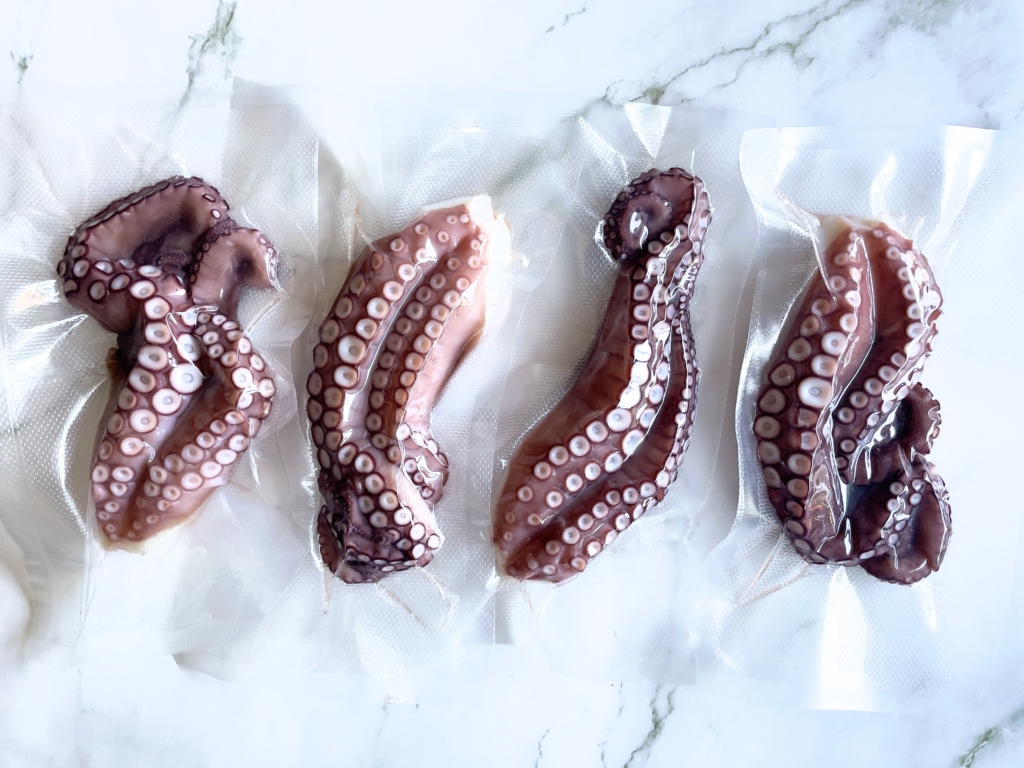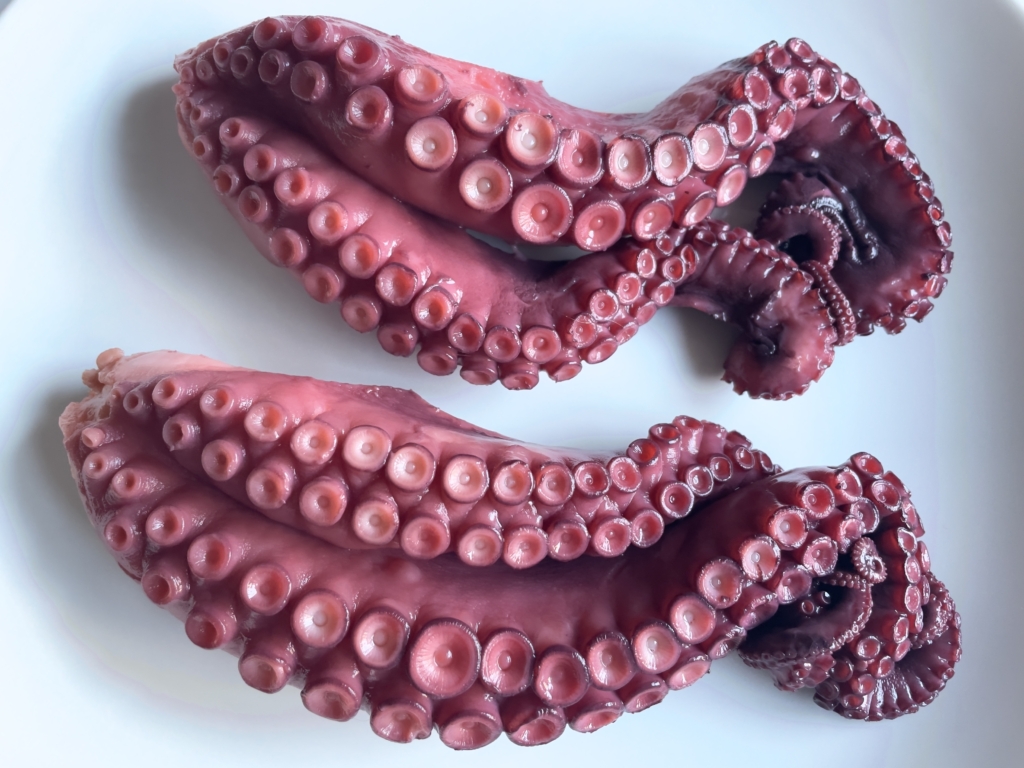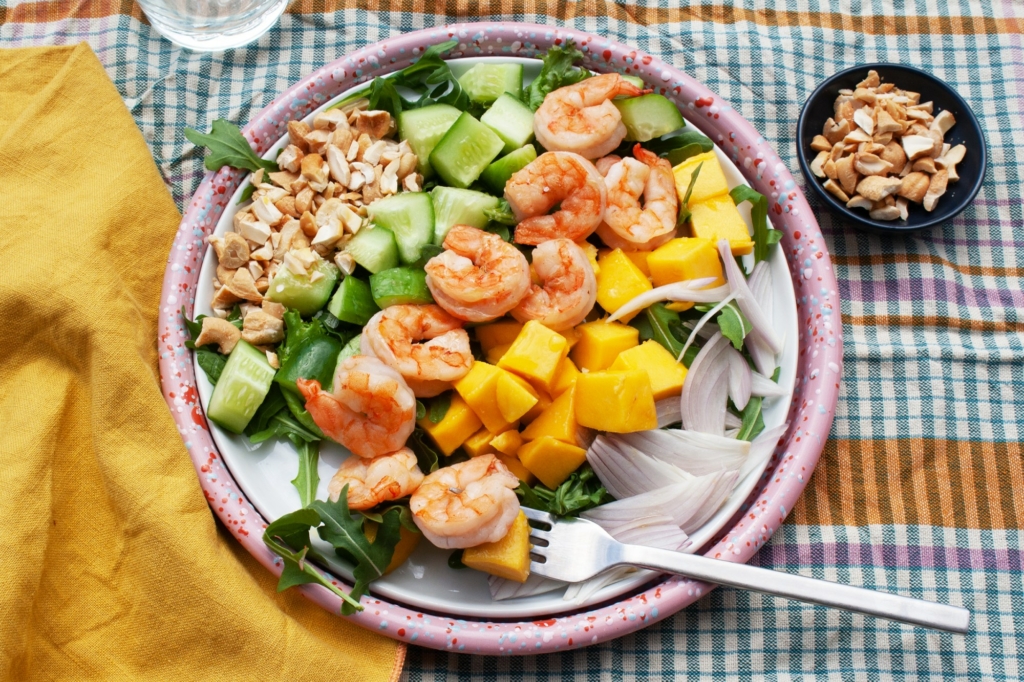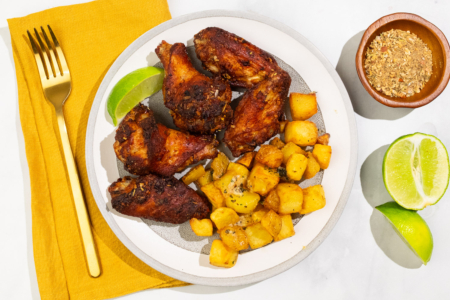Octopus has been a delicacy worldwide for centuries and is very popular in parts of The Americas, Europe, and Asia. There are many ways to cook octopus: it can be grilled, blanched, slow-braised, confited in olive oil, boiled, sautéed, or pressure cooked. It can be served raw and even served live in some parts of South Korea and Japan. Octopus is delicious served chilled, sliced, and added to seafood salads, ceviche, or escabeche. You can also cut it into pieces and add it to fish soups or stews. Cooked octopus can also be dipped in a light batter and deep fried for octopus tempura.
The options for cooking and enjoying octopus are endless! I like to brush it with olive oil and place it on a searing hot grill (or cast-iron skillet on the stovetop) until charred in spots, then allow it to rest for five minutes. Chilled or grilled octopus is delicious served on a bed of romesco sauce, sprinkled with chopped fresh parsley, a lemon wedge alongside, and a drizzle of olive oil.
Sous Vide for Tenderness
Octopus is rich in collagen, so the great thing about using the sous vide method (as well as not having to think about it for five hours!) is the slow, gentle cooking allows the collagen to yield a tenderness that other traditional methods cannot always achieve.
Prepping your Octopus
There is some prep involved when cooking octopus. If possible, ask your fishmonger to clean and remove the beak (which can be found underneath the octopus at the very center of the tentacles), ink sac, and entrails. Octopus head is perfectly edible but has a different texture than the tentacles and can be chewier. I like to ask my fishmonger to remove the head completely, as I find it easier to manage, but it’s a personal preference.
What Size Octopus Should I Choose?
It’s advisable to choose an octopus around two to four pounds, which is a good size to work with and creates perfectly sized portions for plating. A large octopus can feel a little intimidating. Allocating one pound per person is suitable for an entree and half a pound for an appetizer.
Once the octopus is prepped and ready to go, you carefully dip it in boiling water 3 to 4 times, allowing the tentacles to curl up so it is pleasing to the eye when plated. It should then be shocked in an ice water bath to prevent further cooking, then cut into manageable pieces.
Adding Aromatics
Octopus is naturally salty and doesn’t need any additional salt added to the bag. You can add aromatics, such as a bay leaf, sprig of thyme, or a few peppercorns. However, I found that I didn’t need to add any aromatics to enjoy the incredible, delicate flavor of the octopus.
Once cooked, shocking the octopus again in ice water helps to set the skin. Once cooled, thoroughly pat dry the tentacles with paper towels. The natural collagen can create a gelatinous layer of skin on the underside, which is perfectly edible. Still, it’s a personal preference to keep or wipe away this layer with a paper towel.
| Temperature and cooking times for octopus | Device | Temperature Time |
| Suvie | 174°F | 5 hours |
| Immersion Circulator | 174°F | 5 hours |
You must refrigerate cooked octopus within 2 hours of cooking. Store it in an airtight container or freezer-safe resealable bag for up to 3 days in the refrigerator or 2 to 3 months in the freezer.
How To Sous Vide Octopus
| Servings | Active Time | Preheat Time | Cook Time |
| 2 to 4 | 15 minutes | 30 minutes | 5 hours |
Ingredients and Tools
Equipment
- Suvie or immersion circulator
- Large pot or sturdy container (if using an immersion circulator)
- 2 to 4 vacuum sealer bags or freezer-safe resealable bags
- Tongs
Ingredients
- 1 octopus (around 2 to 4 lbs)
- Olive oil, for brushing (if grilling)
Directions

1) If you’re using a sous vide immersion circulator, pre-heat your water bath to 174°F.
2) Ask your fishmonger to remove the beak, which is located underneath the octopus at the center of the tentacles. You can do this yourself by using a sharp paring knife to circle the beak and pull out with your fingers, along with the entrails and ink sac, which is connected. If you are removing the head, you can also ask your fishmonger to do this, but if you are doing it yourself: lay the octopus flat, hold the head upright, and slice horizontally using a sharp chef’s knife to remove. Thoroughly rinse the octopus under cold running water. Pat dry.

3) Meanwhile, bring a large pot of water to a rolling boil and fill a large bowl with ice water. Using tongs, dip the octopus into the hot water 3 or 4 times, for no longer than 30 seconds in total, so that the tentacles curl. Immediately transfer the tentacles to the ice water to shock them and keep them from overcooking. Drain and pat dry.


4) Lay the octopus out flat on a cutting board. Cut across the center from top to bottom; You can leave as 4-tentacles per piece or cut in half again to create 2 per piece—transfer pieces to vacuum or resealable bags and seal. If you are using resealable bags, use the water displacement method.



5) Lower the bags into the heated water bath and cook for 5 hours. Cover the water bath with a layer of ping pong balls, foil, or cling wrap to keep the water from evaporating and sustain the high water temperature.
If you are using your Suvie, place the bag into a Suvie pan and cover entirely with water. Insert pan into the bottom of your Suvie and input the following settings. You may need to cook in batches if the tentacles are overly large.
Suvie Cook Settings
Bottom Zone: Sous Vide at 174°F for 5 hours
6) Just before the 5 hours are up, prepare another ice bath. Remove sealed octopus bags with tongs and transfer to the ice water until thoroughly chilled, around 5 to 10 minutes, to prevent the skin from peeling away. Once chilled, discard cooking liquid from the bags. Thoroughly pat the tentacles dry with paper towels.

7) The octopus is now ready and can be served chilled. Or to grill: brush with olive oil, season with salt and freshly ground pepper, and cook over a hot grill (or cast-iron skillet on the stovetop) until charred in spots, turning occasionally for around 10 minutes.

RECIPES TO TRY:
Romesco Sauce

Suquet de Peix (Catalan Fish Stew)

7 Scrumptious Seafood Recipes

Your Favorite Fish Recipes

Rosé Butter Lobster with Cucumber Avocado Salad

Super Salad Recipes

FAQs
Is it OK to sous vide the whole octopus?
Yes, it is perfectly fine to sous vide the whole octopus. Cut into smaller pieces are easier to bag and manage. Make sure the octopus is thoroughly washed.
Can I use any type of plastic bag?
You can, however, make sure that they are made from polyethylene. Some branded bags are made using polyethylene, a BPA and dioxin-free plastic that can safely handle sous vide cooking temperatures up to 190°F. Some generic branded plastic bags are made using cheaper polyvinyl chloride (PVC), which cannot handle high temps and contains chemicals that can leach into food.
Can I leave my octopus in the water bath indefinitely?
You can sous vide octopus for extended periods won’t result in overcooking, but it may affect the texture.
The bag with the octopus won’t stay fully underwater; what do I do?
This is often a problem with certain proteins and vegetables. If you experience this, there are a few ways to prevent the bag from floating at the top of the water bath. A layer of ping pong balls in the immersion bath will keep the food underwater. Alternatively, you can try and weigh down the bag with a couple of large metal serving spoons.



